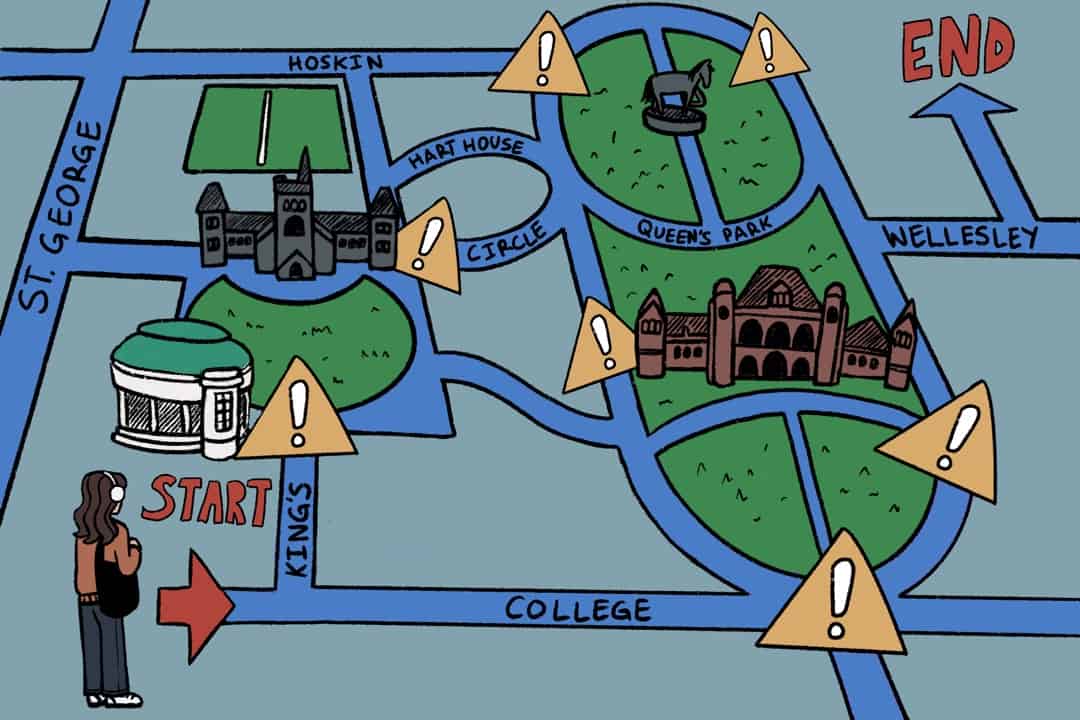Have you noticed the new open stretch of grass in King’s College Circle? Construction in the centre of the UTSG campus — as part of U of T’s Landmark Project — began in 2020, and this fall, three years later, U of T expects to complete the project. Here’s a breakdown of the project and what students can expect from its completion.
What is the Landmark Project?
According to the university, the Landmark Project aims to make the UTSG campus more pedestrian-friendly and increase green spaces on campus.
The project also included installing a geothermal field that will help the university reach the goals laid out in its Climate Positive Campus Plan, a multi-year plan introduced by the Committee on Environment, Climate Change, and Sustainability (CECCS) — a committee created in 2017 to guide the university’s actions addressing climate change. The plan includes measures to ensure that, by 2050, the UTSG campus reduces more emissions than it emits.
After consulting with university stakeholders, a team of architects and urban strategists hired by the university first revealed the Landmark Project plans in April 2016. A one million dollar donation from the universities’ alumni association and another million dollars from the university’s Boundless Campaign — a fundraising campaign that was open to donors around the world — provided the financing for the project.
The architects designing the project also collaborated with groups such as the University of Toronto Students’ Union (UTSU).
Completed parts of the project
According to the university, U of T will use the Alumni Plaza — the area outside Convocation Hall — to honour U of T’s alumni community, particularly during convocation ceremonies. The plaza also aims to provide a safer route for students trying to get to King’s College Circle.
At the centre of the UTSG campus in King’s College Circle, U of T has installed the largest geothermal field in Canada. Geothermal field systems, created by drilling into underground water reservoirs, circulate water or hot steam for heating or cooling or to generate energy. U of T claims that the geothermal field will save an estimated 15,000 metric tonnes of greenhouse gas emissions annually.
Additionally, the university added granite stones to pave Tower Road, which is just north of King’s College Circle. To the west of this road, the Scace Walk — which winds from Hoskin Avenue to the Soldiers’ Tower — now includes concrete bleachers where students can watch sporting events on the Pan Am and Parapan Am fields.
The university has also finished the “welcome path” — an idea proposed by the UTSU to give students a more accessible entrance to the campus “from Queen’s Park,” the Landmark Project page explains. Students can also enjoy two new gardens outside the Medical Sciences Building.
Parts of the project still in construction
The university is still working on building an underground parking garage beneath King’s College Circle, which it expects to open up later this year. The university claims the garage will reduce surface parking in King’s College Circle, making the space more pedestrian-friendly.
Currently, students can already use many of the granite pathways along the Scace Walk, but the university is adding granite pavers along Tower Road, as well as trees and benches. Work continues on the Temerty Plaza, which aims to transform the area north of the Medical Sciences Building into a pavilion with more greenery and outdoor seating for students.
The university has not yet finished constructing a garden — with funding gifted by Chancellor Emeritus David and Shelley Peterson — that will be located south of Hart House. Like the Alumni Plaza, this garden will also include granite pavers connecting Hart House to King’s College Circle.
To the east of Hart House, the Ziibiing project — which aims to pay tribute to the Indigenous populations that lived along Taddle Creek, a now-buried creek that ran along Philospher’s Walk — remains under construction. Once finished, U of T hopes to make it a place for Indigenous students, faculty, and community members to gather.



No comments to display.